My friend Radim has been a beekeeper for 5 years. He’s living in a forested area where his bees are quite for themselves. He started with Elgon bees, but not the very best varieties. He has though been fortunate as there probably are some feral bees a mile away or so which are contributing with good drones for mating. A swarm I took from a feral colony about that distance from him had features showing Elgon influence. This has made him, me and our bees happy.:)
One thing about Radim that has fascinated me is his curiousity of how bees function on their own. He wants to learn their way of living to better help them and also just for the satisfaction of knowing.
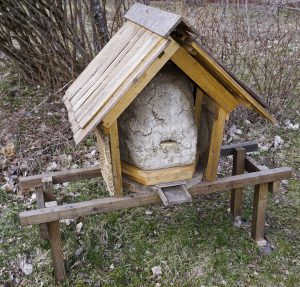 One of his colonies is living i a small skep of straw insulated with cow dung.
One of his colonies is living i a small skep of straw insulated with cow dung.
He has put some colonies on four boxes medium (langstroth width and about 2/3 of Langstroth full depth – 448 x 159 mm) somewhat away in the forest. They have been allowed to build their own combs without the help of wax foundation. He takes no honey and gives as little sugar solution as possible. Last year he had to complement their food reserves for winter as the season was very bad. He also has a small skep insulated with cow dung. He hasn’t treated those hives against mites. He observes what they are doing and not doing.
He told me he caught a swarm in 2015 in another area than his. Obviously this swarm were of another kind of stock as the color of the bees was light in color, yellow. He brought it home to use it for producing splits and mating nucs as he had heard this type of bee didn’t produce as good a crop, but a lot of bees. And this colony really did produce bees. Already in February, 2016 when it still was winter, it had started brooding a lot. Soon he had to feed it so it shouldn’t run out of food.
He decided he didn’t want this type of trait in drones flying in his home area as he was going to let his virgin queens mate there. He moved the colony, actually to a better area concerning nectar sources. The weather was not good for a honey crop in 2016 and he went for a holiday in June. Normally this month bees have no problem finding nectar so he thought there would be no problems for this colony. But when he came back from the holiday a couple of weeks later the yellow colony on two boxes had 7 full combs of capped brood. It had given splits and bees to mating nucs. Besides the 7 capped combs it had not a single drop of food and not one bee alive. The colony was dead.
The other bees Radim has behaves very differently, especially his ”wild” ”feral” bees. The colony in the little skep has wintered three winters and is thriving. The first year Radim fed it some sugar solution so it got enough food for winter. The volume is small and it can’t hold a lot of food – brood or bees either. In 2015 it swarmed three times and Radim got in this way three new colonies.
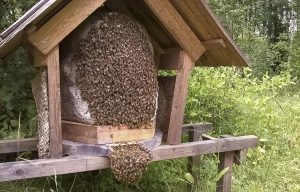 It was a lot of beees in the skep in 2016, but they didn’t swarm.
It was a lot of beees in the skep in 2016, but they didn’t swarm.
In 2016 in June the bee population was big and bees were sometimes covering the outside of the skep and he expected a swarm, that though didn’t come. In late June the bees almost stopped flying and did nothing. They had apparently decided the season was over and were waiting for winter and next season. And the season was really over.
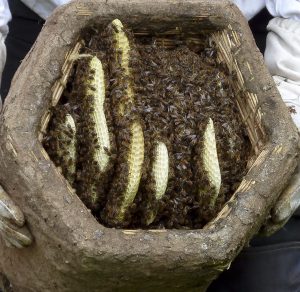 At the end of June the bees in the skep decided the season was over. And it really was. No more real flow that year.
At the end of June the bees in the skep decided the season was over. And it really was. No more real flow that year.
No more good honeyflow that year. The skep was heavy of honey. The bees the rest of the season were just sitting by the entrance (and inside of course) watching (and maybe meditating).
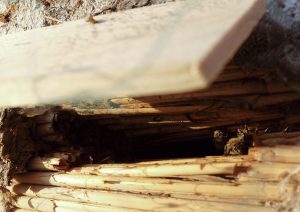 The bees were cool the rest of the season and waited for next season. Checking what’s up now end then. Here in January 2017.
The bees were cool the rest of the season and waited for next season. Checking what’s up now end then. Here in January 2017.
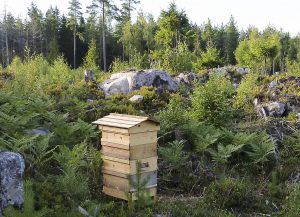 The “feral” colonies on medium boxes behaved like the bees in the skep. Here’s one of them somewhat on its own in the forest.
The “feral” colonies on medium boxes behaved like the bees in the skep. Here’s one of them somewhat on its own in the forest.
One of the four box ”feral” hives was behaving in an identical way. This hive has the entrance on the middle of the wall of the second box. The bees anyway clean the bottom well from debris. The combs in the first box consists of almost only drone comb. In winter 2016 the bees are sitting close to the entrance in the second box and also in the third. The fourth box is full of honey and some additional sugar for winter feed. When you look from above you can’t see the bees, but you can hear them, a soft buzz.
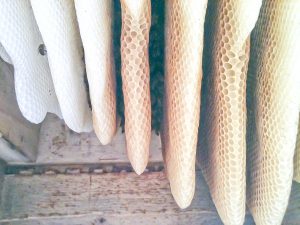 Through the inspection door at the back of the colony he can see the combs in the first box. Here the bees can bee seen sitting close to the entrance in the second box.
Through the inspection door at the back of the colony he can see the combs in the first box. Here the bees can bee seen sitting close to the entrance in the second box.
Even when the sun is shining ritght onto the bees close to the entrance (the sun is low above the horizon in winter in Sweden) they don’t move and come out. Once in a while when he looked into the entrance he could see a bee move around a little and make its way into the cluster.
In January on a sunny day he could see one bee coming out from that hive, fly up against the sun, higher and higher, and never return. It was a bee that had warmed the cluster with its muscle movements until it had come close to being worn out having done what had been it’s task in life, keeping its mates alive creating warmth. Now its engine had come to its end and the bee went up to the heaven for bees.
A wonderful story, thanks Erik and Radim.